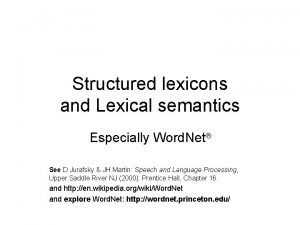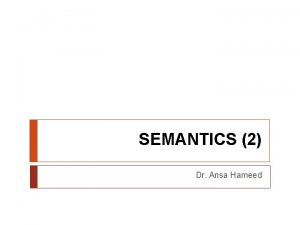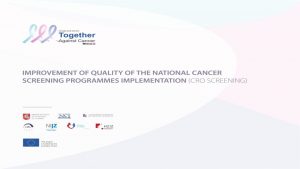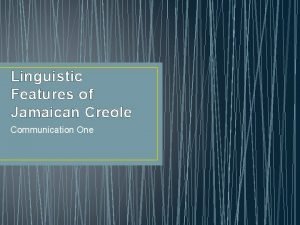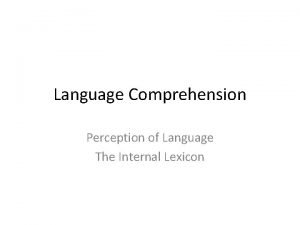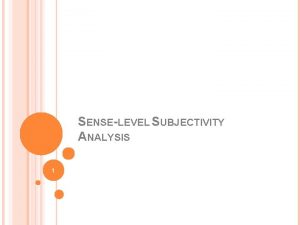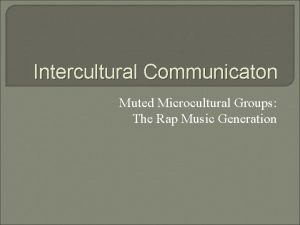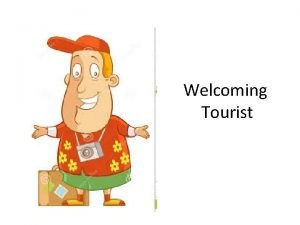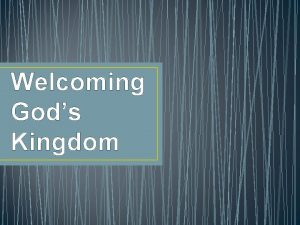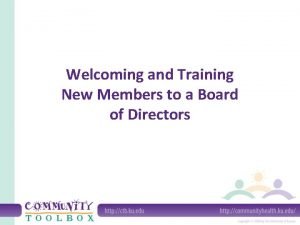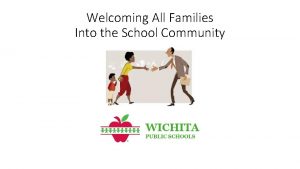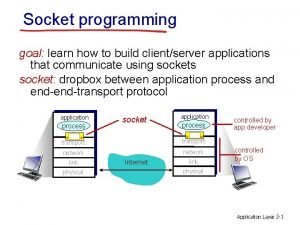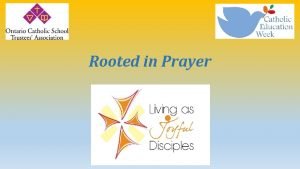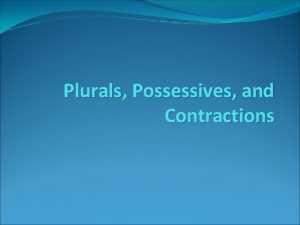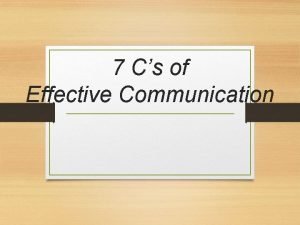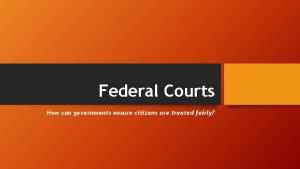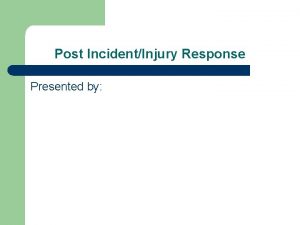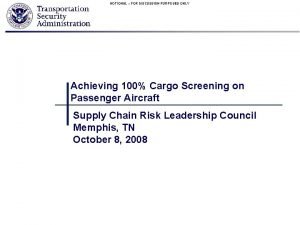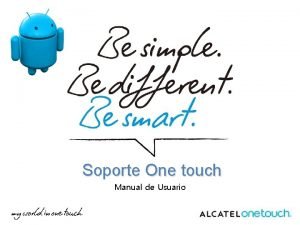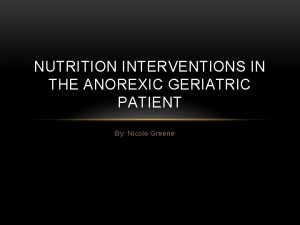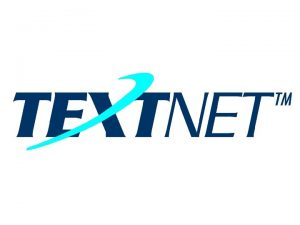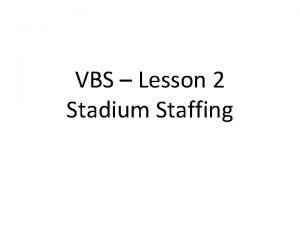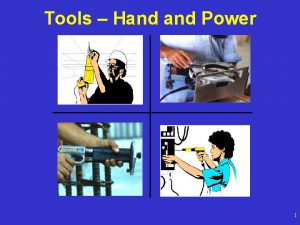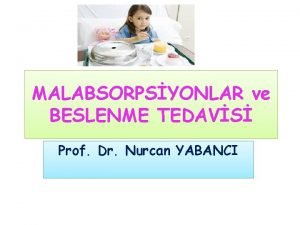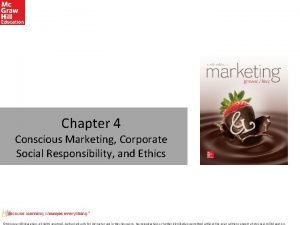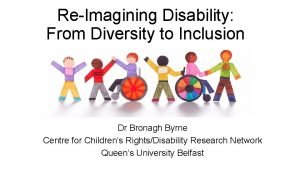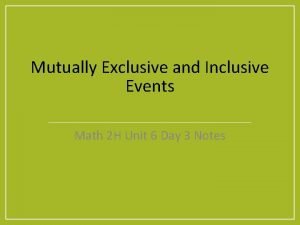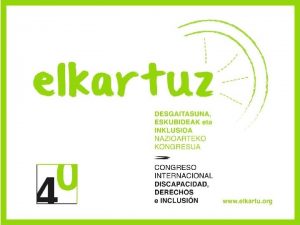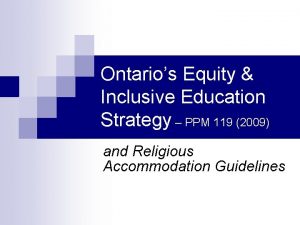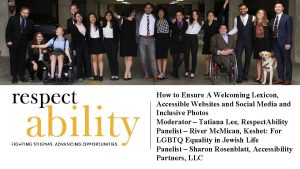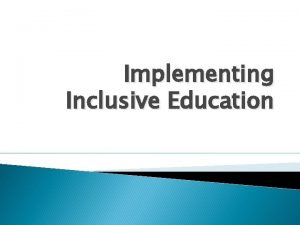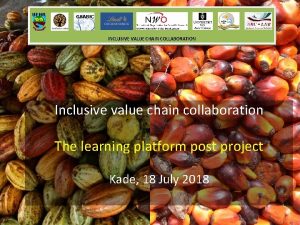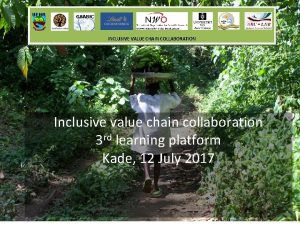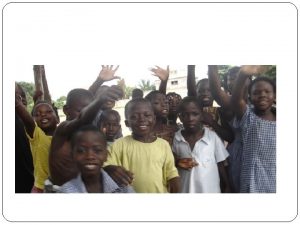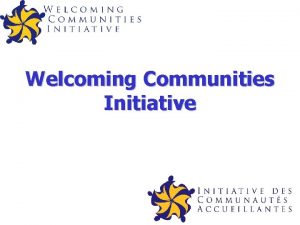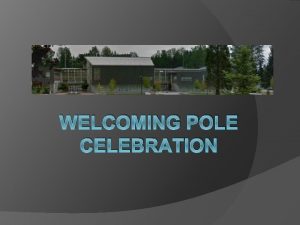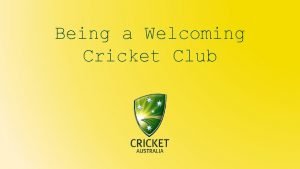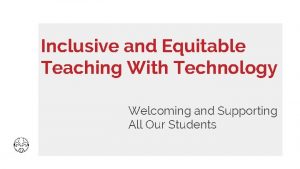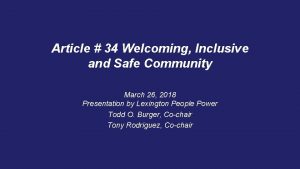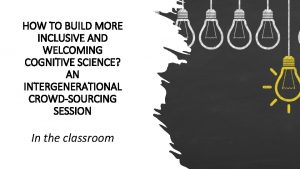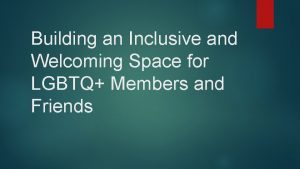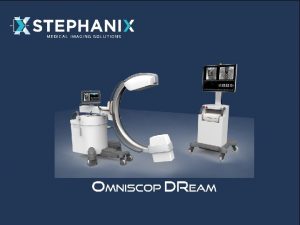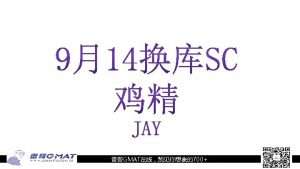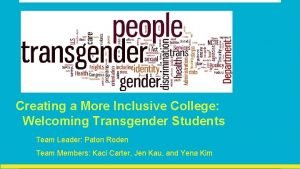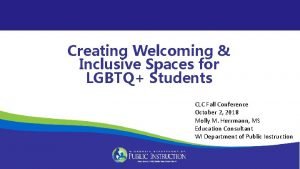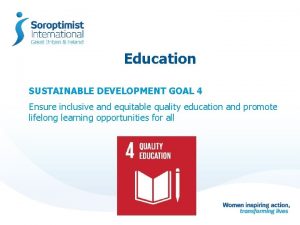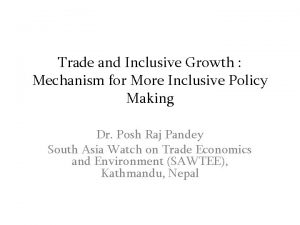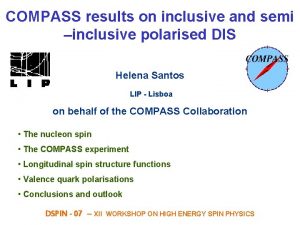How to Ensure A Welcoming Lexicon and Inclusive



































- Slides: 35

How to Ensure A Welcoming Lexicon and Inclusive Storytelling

Equity and Access Webinar Series Partners • Board. Source • The California Wellness Foundation • Catalogue for Philanthropy, Greater Washington • Center for Disaster Philanthropy • Cerebral Palsy Foundation • The Chronicle of Philanthropy • The Communications Network • The Divas With Disabilities Project • Exponent Philanthropy • Grantmakers Concerned with Immigrants and Refugees • Media Impact Funders • National Center of Disability Journalism • National Committee for Responsive Philanthropy • National Council of Nonprofits • The New York Women’s Foundation • The Unfunded List • Weingart Foundation

Including the D – Disability – in Diversity Organizations are at their best when they welcome, respect and include people of all backgrounds. This includes people with disabilities.

These are people with disabilities.

61 Million people in the U. S. have a disability. * People with disabilities want opportunities Just like anyone else. * Source: US Census

1 in 4 adults have a disability

Disabilities Are…. Temporary and Permanent Visible and Nonvisible From Birth or Acquired Later

Speakers Moderator: Lauren Appelbaum Vice President, Communications, Respect. Ability She/hers Kristin Gilger Director, the National Center on Disability and Journalism Senior Associate Dean and Reyolds Professor in Business Journalism Walter Cronkite School of Journalism and Mass Communication She/hers Dr. Donna R. Walton, Ed. D. Founder and President, Divas With Disabilities, Inc. She/hers

Words Matter

Defining Disability • The U. S. government defines disability as “a physical or mental impairment that substantially limits one or more major life activities. ” • Major life activities include such activities as caring for oneself, performing manual tasks, walking, seeing, hearing, speaking, breathing, learning and working. • Both temporary and permanent disabilities are covered by the ADA.

Defining Disability: Census • • • Hearing Vision Cognitive Ambulatory Self-care Independent living Respondents who report any one of the six disability types are considered to have a disability.

Basic Rule No. 1: Disability and people who have disabilities are not monolithic. Avoid referring to “the disabled” in the same way that you would avoid referring to “the Asians, ” “the Jews” or “the African. Americans. ” Instead, consider using such terms as “the disability community” or “the disability activist. ”

Basic Rule No. 2: People with disabilities do not want to be seen as victims. Many have long-term conditions with which they lead full and active lives. Instead of “he suffers from cerebral palsy, ” use “he has cerebral palsy” (if it’s pertinent to the story). Instead of “he was stricken with paralysis, ” use “he became paralyzed. ”

People-First Language Puts the emphasis on the person first; followed by a description of the disability. EXAMPLES: A person who lives with a disability vs. a disabled person A person with an intellectual disability vs. mentally disabled A person who is epileptic vs. epileptic

Identity-First Language Puts the emphasis on the disability. EXAMPLES: Autistic, deaf, blind, disabled An autistic woman vs. woman with autism Several U. S. disability groups have always used identity-first terms, specifically the culturally Deaf community and the autistic rights community.

People First vs. Identity First Language If you are working with individuals with disabilities, ask them their preference.

Say the Word Disability / Disabled Not “special needs” or “differently abled”

Terminology Tips: Using Appropriate Lexicon

NCDJ Disability Language Style Guide http: //ncdj. org/style-guide/

Attention-deficit disorder (ADD)/attention-deficit hyperactivity disorder (ADHD) Background: ADD and ADHD refer to attention-deficit disorder and attention-deficit hyperactivity disorder, respectively. Both are common mental disorders that manifest primarily in children, according to the National Institute of Mental Health. Common symptoms for both disorders include restlessness, difficulty in focusing or staying organized, and impulsivity. Those with an ADHD diagnosis also exhibit a difficulty in sitting still or engaging in quiet activities. Some debate exists as to the accuracy of an ADHD or ADD diagnosis as an actual disorder. NCDJ Recommendation: Refer to someone as having attention-deficit disorder or attention-deficit hyperactivity disorder only if the information is relevant* to the story and if a licensed medical professional has formally diagnosed the person. Use “attentiondeficit disorder” or “attention-deficit hyperactivity disorder” upon first reference; ADD and ADHD are acceptable for each disorder on second reference, respectively. AP style: Not addressed

Make it Accurate Confined to a wheelchair or wheelchair-bound: These terms describe a person only in relationship to a piece of equipment. They are misleading, as wheelchairs can liberate people, allowing them to move about. They are inaccurate, as people who use wheelchairs are not permanently confined in them, but transfer to sleep, sit in chairs, drive cars, etc.

Make it Accurate (continued) Mental condition is an umbrella term for many different conditions that affect how individuals act, think, feel or perceive the world. The most common forms of mental conditions are anxiety disorders, mood disorders, and schizophrenia disorders. NCDJ Recommendation: Refer to an individual’s mental condition only when it is relevant to the story and the diagnosis comes from a proper source. Whenever possible, specify the specific condition a person has rather than mental conditions in general. AP style: The stylebook cautions against describing an individual as having a mental condition unless clearly pertinent to a story and the diagnosis is properly sourced. Specific conditions should be used and the source of the diagnosis identified whenever possible.

Other Language Person without a disability or nondisabled, not “able-bodied” or “normal. ” People with disabilities should not be described as “inspirational” or “courageous” just because they have a disability.

Importance of Storytelling and Diverse Visual Representations

The Divas With Disabilities Project Mission: To reshape what disability looks like by promoting Black and Brown women and girls with physical disabilities through various media platforms.

Imagery Tells A Story Divas with Disabilities: Our Images Tell Our Story

Beauty With a Twist

Disability Impacts Everyone Disability impacts people of all races, sexual orientations and gender identities, faiths and backgrounds. • African Americans with Disabilities • Latinx People and Hispanics with Disabilities • Women with Disabilities • LGBTQ+ Individuals with Disabilities

Nothing Without Us The best way to accurately represent people with disabilities is to include us in the storytelling process!

Shattered Dreams, Broken Pieces An eye-opening tale of reinvention, Shattered Dreams, Broken Pieces is the story of the decades Donna Walton spent working to rebuild her world and discovering new confidence and a fresh sense of purpose along the way. https: //www. amazon. com/Shattered-Dreams-Broken -Pieces-Walton/dp/1533595151

Inspiration Porn

How to Avoid Inspiration Porn Inspiration porn is when people with disabilities are called inspirational or brave for doing something as simple as exercising or being invited to a prom. Per the TV show Speechless, “It’s a portrayal of people with disabilities as one-dimensional saints who only exist to warm the hearts and open the minds of ablebodied people. ” Inspiration porn assumes that anyone with a disability must have it so much worse, and it uses people with disabilities to make nondisabled people feel good about themselves or to make them do something, like exercise.

Q&A with the Speakers Moderator: Lauren Appelbaum Vice President, Communications, Respect. Ability She/hers Kristin Gilger Director, the National Center on Disability and Journalism Senior Associate Dean and Reyolds Professor in Business Journalism Walter Cronkite School of Journalism and Mass Communication She/hers Dr. Donna R. Walton, Ed. D. Founder and President, Divas With Disabilities, Inc. She/hers

Equity and Access Webinar Series Schedule • Disability 101 (available online via video and transcript) • Disability History (available online soon!) • How to Ensure Accessible Events (available online via video and transcript) • How to Recruit, Accommodate and Promote People with Disabilities for Volunteer Leadership, Board Positions and Paid Employment (available online via video and transcript) • How to Ensure A Welcoming Lexicon and Inclusive Storytelling (available online soon!) • Jan. 7, 2020: How to Ensue Accessible Websites, Social Media and Inclusive Photos • Jan. 9, 2020: Premium Skills Workshop in Social Media Accessibility • Jan. 15, 2020: How to Ensure Legal Rights and Compliance Obligations: Exploring the Rights of Employees and Participants, and the Obligations of Nonprofit Organizations Under the Law Learn More and RSVP Here: https: //www. respectability. org/accessibility-webinars

Resources and Thank You! Respect. Ability’s Inclusive Philanthropy Toolkit Access information on disability inclusion, including the new disability in philanthropy & nonprofits study: www. Respect. Ability. org/inclusivephilanthropy Follow us on Social Media! Twitter: @Respect_Ability Facebook: Respect. Ability. USA Instagram: @Respect. The. Ability www. Respect. Ability. org | (202) 517 -6272 | info@Respect. Ability. org Intersection of Disability and Politics: www. The. Respect. Ability. Report. org
 Arrival and departure list in hotel
Arrival and departure list in hotel Lexicon semantics
Lexicon semantics Semantic features definition
Semantic features definition Mental lexicon
Mental lexicon Birads classification
Birads classification Creole features
Creole features Internal lexicon
Internal lexicon Noah webster emily dickinson
Noah webster emily dickinson Mpqa subjectivity lexicon
Mpqa subjectivity lexicon Muted group theory
Muted group theory Open lexicon
Open lexicon How to welcome tourist as a tour guide
How to welcome tourist as a tour guide What is the kingdom of god in the old testament
What is the kingdom of god in the old testament Welcoming new board members
Welcoming new board members Welcoming all families into the school community
Welcoming all families into the school community Dua welcoming ramadan
Dua welcoming ramadan Client in programming
Client in programming Welcome prayer introduction
Welcome prayer introduction Singular possessive nouns ending in s
Singular possessive nouns ending in s It implies stepping into the shoes of others
It implies stepping into the shoes of others Enteralna i parenteralna prehrana
Enteralna i parenteralna prehrana Harmony in self and body
Harmony in self and body How can governments ensure citizens are treated fairly
How can governments ensure citizens are treated fairly Purpose of ensure
Purpose of ensure The iac must ensure custody of air cargo using what methods
The iac must ensure custody of air cargo using what methods Ensure touch manual
Ensure touch manual '+elderly +ensure
'+elderly +ensure Ensure
Ensure Stadium staffing
Stadium staffing Powder actuated tool safety
Powder actuated tool safety Ensure diyabetik mama
Ensure diyabetik mama Csr vs conscious marketing
Csr vs conscious marketing Reimigining disability and inclusive education
Reimigining disability and inclusive education Exclusive and inclusive math
Exclusive and inclusive math Reimigining disability and inclusive education
Reimigining disability and inclusive education Ontario's equity and inclusive education strategy
Ontario's equity and inclusive education strategy

